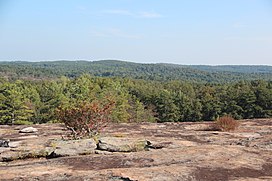| Arabia Mountain | |||||||||||||||||
|---|---|---|---|---|---|---|---|---|---|---|---|---|---|---|---|---|---|
 View from the summit of Arabia Mountain | |||||||||||||||||
| Highest point | |||||||||||||||||
| Elevation | 955 ft (291 m) | ||||||||||||||||
| Prominence | 172 ft (52 m) | ||||||||||||||||
| Coordinates | 33°39′54″N 84°7′6″W / 33.66500°N 84.11833°W | ||||||||||||||||
| Geography | |||||||||||||||||
 | |||||||||||||||||
| Location | DeKalb County, Georgia | ||||||||||||||||
| Climbing | |||||||||||||||||
| First ascent | unknown | ||||||||||||||||
| Easiest route | Hike | ||||||||||||||||
| |||||||||||||||||
Arabia Mountain, a part of Arabia Mountain National Heritage Area, is the northern of two peaks in the Davidson-Arabia Mountain Nature Preserve, in DeKalb County, Georgia, United States. A low saddle separates it from Bradley Mountain, several hundred feet to its south. The two form a monadnock. The peak is 955 feet (290 m) above sea level, rising 172 feet (52 m) above Arabia Lake reservoir. Bradley Mountain is closer to the visitor trails than Arabia Mountain and is often misidentified by visitors as Arabia Mountain.
The mountain is also in a namesake National Heritage Area[1] in the U.S. state of Georgia that encompasses natural, cultural, and historical elements to form a cohesive, nationally significant landscape.[2] The area is due east of Atlanta and spans 40,000 acres (16,000 ha) reaching from the historic commercial center of Lithonia to the Monastery of the Holy Spirit in Conyers, including a number of sites in between, including Panola Mountain State Park, Davidson-Arabia Mountain Nature Preserve, the historic Flat Rock Community with the Flat Rock Archives, and more. The National Heritage Area was established in 2006 and is coordinated by the Arabia Mountain National Heritage Area Alliance, which includes board members, representatives from the community and local organizations, and staff.
Additionally, Davidson-Arabia Mountain Nature Preserve includes 2,550 acres in DeKalb County, Georgia with a multi-use bike path, hiking trails, and lakes for fishing. The park features large exposed granite formations, wetlands, pine forest, oak forest, streams habitat and two lakes. Plant species include the rare red diamorpha in the winter and yellow daises in the fall. The area included rock quarries and abandoned structures from the mining operations.[3]
- ^ "Arabia Mountain National Heritage Area (U.S. National Park Service)". www.nps.gov. Archived from the original on July 13, 2013. Retrieved February 5, 2020.
- ^ "Heritage Areas, National Park Service, Frequently Asked Questions." National Park Service. Accessed February 10, 2015. http://www.nps.gov/heritageareas/FAQ/.
- ^ Arabia Alliance

